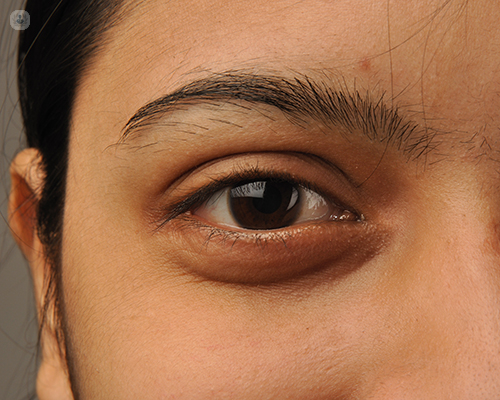Multifocal lenses: benefits and suitable candidates
Written by:Multifocal lenses can help a great deal when it comes to correcting age-related changes where the eye struggles to focus on objects at a close distance.
In our latest article, revered consultant ophthalmologist, Mr Scott Robbie, explains what multifocal lenses are, outlines the main benefits and disadvantages of having them inserted into the eye, and reveals who might and might not be suitable for multifocal lenses.

What are multifocal lenses?
Multifocal lenses are intraocular lenses, which means that they are designed to be put inside the eye to replace a patient’s natural lens, or, if the natural lens has become cloudy, replace what we call a cataract. If a patient has multifocal lenses, there are set zones which they can make use of to see an object in focus.
What are the main benefits of multifocal lenses?
They are designed to reduce a patient’s dependence on glasses. So, instead of having a single plane of focus, like a monofocal lens, multifocal lenses are designed to take a packet of light and divide it in such a way as to replicate the effects of accommodation (the ability to focus from distance to near when we are younger).
Depending on the lens, some of the light may be made available for distance, some for intermediate vision (looking at a computer screen for example), as well as some being made available for near vision, so that a patient can read unaided.
What are the main disadvantages of multifocal lenses?
We are only taking a packet of light (only a fine amount of light entering the eye), and dividing that light and splitting it so that different amounts (of light) are available for different distances. This reduces the amount of overall light available, for example, for distance vision and for intermediate vision, or indeed near.
Therefore, patients who have these kinds of lenses will experience some reduction in what’s called their contrast sensitivity, which is their ability to resolve, for example, different shades of grey when they’re reading.
As a result, they may find that when they are in a dimly-lit restaurant (even though they have had multifocal lenses implanted), they still maybe need to get some glasses out to read the menu. These lenses can also generate a little bit more of haloes around lights and glare, which patients will be aware of, at least initially after having the lenses implanted.
Over time, however, these effects become less and less obvious as the brain gets used to the new way of seeing. This is referred to as neuroadaptation. As a consequence, the vast majority of patients do not find these drawbacks too unsettling.
Having said that, there are a minority of patients that do find them troubling, to the extent that they don’t tolerate these sorts of lenses and may even ask to have them removed and replaced by a standard monofocal lens.
Who is the ideal candidate for multifocal lenses?
Not all patients are suitable candidates for these sorts of lenses. Multifocal lenses, generally speaking, tend to work best in patients who have a relaxed personality, who don’t focus so much on the various optical drawbacks of these lenses.
Also, because these lenses are optically quite demanding, the optics of the eye cannot have too much irregularity nor too much scatter of light passing through the eye once, let’s say, after a cataract has been removed.
Similarly, your surgeon must aim to eliminate any residual glasses prescription after the surgery. This may involve implanting a lens that reduces the amount of astigmatism (rugby ball shape as opposed to football shape) in the eye or managing this afterwards with a laser eye surgery procedure.
Some patients with dry eyes may not be such great candidates for multifocal lenses, because any scattering of light caused by the unevenness of the tears coating the surface of the eye will aggravate the sense of glare or halo that the use of these lenses can generate. The retina also has to be in a healthy state so that the patient can deal with the images supplied.
How effective are multifocal lenses for helping eyesight?
Many patients get excellent results from these sorts of lenses. Full independence from glasses cannot be guaranteed, but for patients interested in having not only distance vision but also near vision as well, these lenses are a great choice.
What are the alternatives to multifocal lenses?
Whether or not patients decide to have multifocal lenses implanted really depends on their own visual needs, their hobbies, what they do for their work, whether they use computers, or look at their phone a lot. All of these factors play a crucial role when patients are considering the various options for improving their eyesight.
One of the main alternatives to having multifocal lenses inserted into the eyes involves aiming for unaided distance vision in one eye (usually a patient’s dominant eye) whilst leaving the other eye short-sighted, to allow the patient to make use of unaided near vision. This approach is called monovision, and avoids some of the drawbacks of multifocal lenses.
Monovision may not necessarily achieve the same levels of glasses independence for a patient as multifocal lenses, but it can be a good option for many. Some patients do not tolerate the slight difference in the glasses’ prescription between the two eyes that comes with a monovision approach, but the majority of patients are able to use both eyes together without noticing this.
Another good alternative is a spin on multifocal lenses called extended depth-of-focus lenses. These lenses are thought to be a better option for patients who might not necessarily be good candidates for more established multifocal lenses. However, they might not provide as much unaided near vision.
Recently, enhanced monofocal lenses have been developed. These are also a potentially effective alternative for patients who may not be suitable for multifocal lenses, but who would benefit from better intermediate vision, along with distance vision.
They are designed with very sophisticated optics which make the transition from distance to intermediate less obvious. They may also afford some unaided near vision with a monovision approach, but without generating as much in terms of the glare and haloes that can come with traditional multifocal lens designs.
If there is no cataract in the eye, then some surgeons may offer a form of laser eye surgery to patients who want to reduce their dependence on reading glasses. This surgery aims to reshape the cornea (the clear window at the front of the eye) to improve focusing for near vision.
The effect is similar to monovision or enhanced monofocal lenses (discussed above) and is less likely to result in full independence from the use of glasses. Re-shaping the cornea in this way can impact on the suitability of a patient for multifocal lens implantation at a later stage, but does not involve going inside the eye to do any surgery.
Mr Scott Robbie is a highly esteemed London-based consultant ophthalmologist who specialises in eye lens replacement. Visit his Top Doctors profile today to book a consultation with him.



